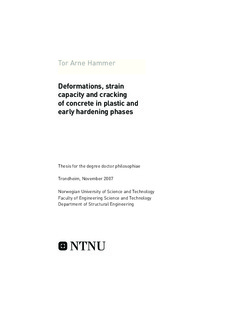| dc.description.abstract | Field observation reveals that cracking of free concrete surfaces in the period before and during setting, may appear at two basically different ages: Minutes after surface finishing, here called “plastic phase” and at some hours after surface finishing, here called “early hardening phase”. This has been verified by tests in the present work by investigating the deformations and strain capacities in both phases, as well as the crack initiation and propagation.
In the plastic phase, the rate of water evaporation relative to the permeability of the concrete (i.e. the ability to transport water to the surface) is the dominating factor. It follows that the “critical” evaporation rate decreases with decreasing permeability, e.g.concretes with relatively low permeability, i.e. with relatively low water-to-powder ratios (like HSC and SCC) have low critical rates.
When the evaporation rate is high relative to the permeability, an important point is the very early formation of capillary tension of pore water (meniscus system) at the surface, which appears as a skin formation. It results in shrinkage of the skin (“plastic shrinkage”), but probably more important, in very low strain capacity of the skin. The latter suggests that deformations caused by differential settlement (as results of reinforcement bars or cross section shifts) and even relatively small external deformations (e.g. formwork movement) may then result in cracking. Furthermore, the skin formation, and thus high cracking risk, may in practise appear before any curing aid is applied.
It is suggested that cracks initiate by emptying of surface cavities (or coarse surface pores): Such cavities will empty (if not already empty) before the pores between the cement grains. Then, there is no meniscus left to restrain the cavities, and they will open as the shrinkage continues.
The fact that both deformation and strain capacity are result of capillary tension of the pore water, suggests that pore water pressure (e.g. as measured in the present work) can be used as a single measure to assess the cracking risk in the plastic phase.
Cracking in the early hardening phase, may be assessed as for hardened concrete, e.g. from the stress-tensile strength ratio, where the stress is result of the restrained drying shrinkage and thermal dilation (autogenous shrinkage may contribute in very low w/b systems).
A promising methodology has been developed to measure deformation, tensile strain capacity, stress generation and tensile strength evolution in the early hardening phase, and the results confirm that the period is critical for cracking. It is shown that the deformation of surfaces in this period caused by moderate drying (here exposed to 20 ºC and 50 % RH) combined with a moderate cooling (here approximately 5 °C), generate restraining stress that may exceed the tensile strength, and thus, generate failure. | nb_NO |
